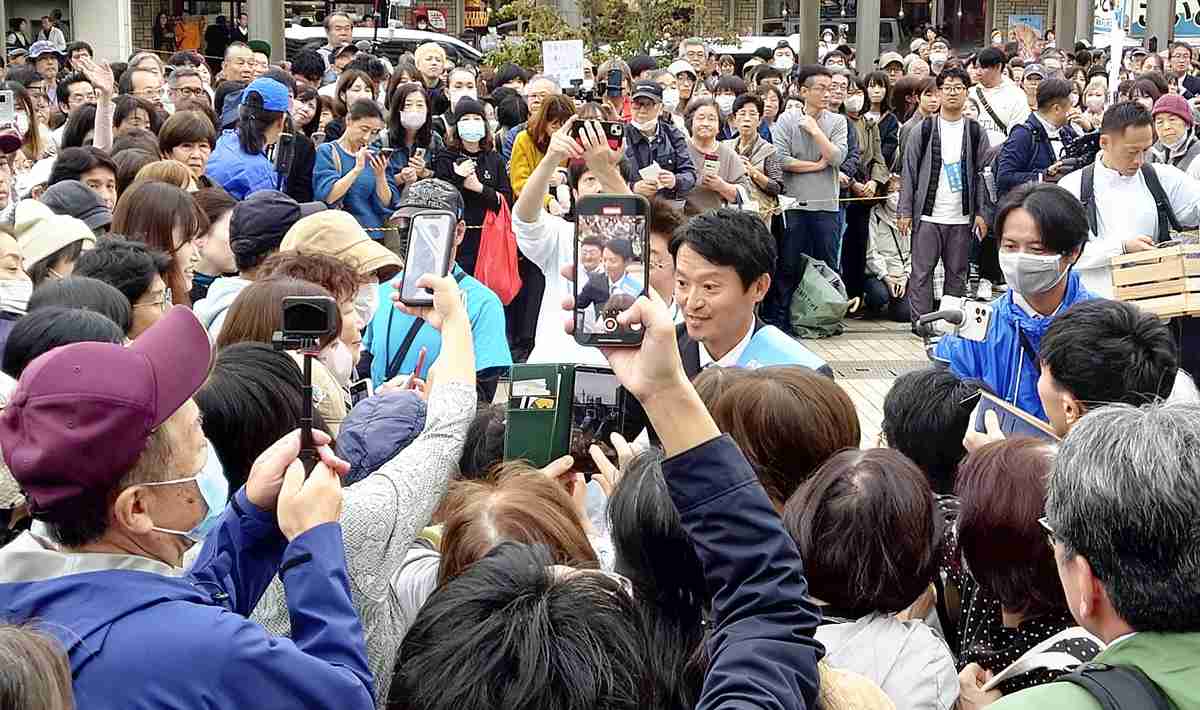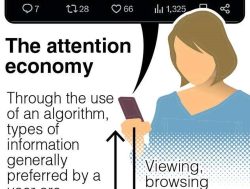Social Media and Elections: Lessons from Hyogo / Competition to Rack Up Views Distorts Election Campaigns in Japan; Attracting Attention for Profit Often Higher Priority Than Accuracy

Motohiko Saito is surrounded by people with smartphones during a campaign event in Tarumi Ward, Kobe, on Nov. 15.
The Yomiuri Shimbun
7:00 JST, November 27, 2024
The spread of information on social media — including posts that are difficult to verify and others with extreme comments — is believed to have contributed to Motohiko Saito’s successful reelection bid in the Hyogo Prefecture gubernatorial election. This is the first installment in a series examining how social media is impacting elections.
***
Motohiko Saito, 47, was reelected as the governor of Hyogo Prefecture on Nov. 17 after having been ousted from the post in September when the prefectural assembly unanimously passed a no-confidence motion against him over accusations of harassment.
On the evening of the election day, people who had gathered in the area around his campaign office in a shopping district in Kobe’s Chuo Ward were extremely excited following his victory.
The 10-meter-wide shopping arcade was packed with his supporters for dozens of meters, and people called out Saito’s name repeatedly as if they were at a concert.
“The web has won!” a 43-year-old man from Saitama Prefecture shouted while live streaming the situation on YouTube.
‘Thanks to Saito’
The man runs the “Fukumaro Net News Channel” on the video-sharing website.
While working as a company employee, he used to live stream his commentaries on games on his channel but was unable to get many views. However, the number of views suddenly increased three years ago after he posted videos of Diet debates that he had edited.
Having begun to receive several hundred thousand yen in advertising revenue per month, the man became a full-time “political YouTuber.”
While continuing to produce videos, he visited places around the country where elections were being held. In July, he followed Shinji Ishimaru, 42, a former mayor of Akitakata, Hiroshima Prefecture, who ran in the Tokyo gubernatorial election.
The man said he had no particular interest in Saito, but started gathering information on him on X, formerly Twitter, after seeing a post in support of Saito on the social media site in September by a celebrity he follows. The man said he then began to question the remarks that commentators made against Saito on TV.
Through social media, the man also felt growing public interest in Saito and the issues surrounding him, so he decided to follow Saito for his YouTube channel.
He went to Hyogo Prefecture one day before the official kickoff of campaigning for the gubernatorial election. Spending nights in his car, he live streamed Saito’s speeches. Considering the costs, the man said it was a “gamble” as to whether the videos would make a profit. But the number of views his channel received increased day by day, and topped 1.7 million on the day of the vote.
“I earned the highest profit ever. It’s all thanks to Saito,” he said.
The man distributed more than 80 videos during the campaign period. He also streamed videos of Takashi Tachibana, 57, another candidate in the Hyogo election and the head of the political group NHK Party, making remarks that are difficult to verify.
“I do think there is information that hasn’t been confirmed to be true,” the YouTuber said. “But I’m fine as long as my viewers are pleased.”
Pro-Saito channels pop up
According to the Net Communication Research Institute, a think tank specializing in social media analysis, there were many YouTube channels supporting Saito, and the number of views of at least 13 exceeded those of Saito’s own YouTube channel.
On social media sites, advertising revenue increases based on the number of views. For this reason, attracting attention is often considered to be more important than accuracy or fairness — a characteristic of what is called the “attention economy.”
“There are believed to have been videos made for profit [in relation to the Hyogo election],” said Yoshimi Nakamura, the head of the research institute. “With the success of live streamers in the election, competition for attention is likely to intensify in future polls.”
786 posts multiply into 490,000
The spread of interest in Saito can also be seen in posts on X.
The Yomiuri Shimbun asked Prof. Fujio Toriumi of the University of Tokyo, who specializes in computational social science, to analyze the posts on X during the campaign period from Oct. 31 to Nov. 16. It found that the number of posts mentioning Saito during these dates was 1.6 times greater than the total number of posts mentioning the other six candidates.
Such posts were spread by a small number of accounts. Of about 990,000 posts that showed support for Saito, about 490,000 posts were based on 786 original posts from just 16 accounts. The 16 accounts made up only 0.9% of the total accounts that were related to the 990,000 posts favoring Saito.
The Yomiuri Shimbun found that some of the posts were difficult to verify with evidence. For example, some of them linked the death of a prefectural official who accused Saito of workplace bullying and other allegations with the official’s personal information, which was unrelated to the accusation and was stored on an official computer. However, the police said they could not determine the reason for the official’s death.
“It had been believed that the relationship between the spread of social media and elections in Japan is weak, but this time, it is considered that it had a certain impact on voting behavior,” Toriumi said. “People should approach social media with the assumption that there is misinformation on it, and we should discuss the role of social media in elections as a society.”
Popular Articles
Popular articles in the past 24 hours
-

Suntory to Halt Jim Beam Distillery in Kentucky for Year
-

Japan Prime Minister Meets With Anime, Music Experts to Discuss D...
-

H3 Rocket Failure Disrupts Timeline for ‘Japanese GPS’
-

70% of School Institutions in Japan Fail to Check New Database on...
-

In the Italian Alps in a Region That Will Host the 2026 Winter Ol...
-

U.S. Hoping to Use Heavy Weapons in Training at 5 GSDF Sites
-

Sumo Scene / 2 New Yokozuna Make 2025 a Year of Great Upheaval, 2...
-

Shrine Maidens Assemble Treasure Ships Ahead of New Year's Pilgri...
Popular articles in the past week
-

U.S. Senate Resolution Backs Japan, Condemns China's Pressure
-

Sharp Decline in Number of Chinese Tourists But Overall Number of...
-

Japan Set to Participate in EU's R&D Framework, Aims to Boost Coo...
-

As Chinese Tourists Shun Japan, Hotels and Stores Suffer
-

Bus Bound for Hokkaido's New Chitose Airport Catches Fire Wednesd...
-

AI Personalizes Foreign Language Lessons in Pilot Projects, Inspi...
-

Rakuten Develops New Large Language Model; ‘Rakuten AI 3.0’ Is On...
-

Popularity of Piggy Banks Across Time and Place Seen at Bank's Mu...
Popular articles in the past month
-

Tokyo Economic Security Forum to Hold Inaugural Meeting Amid Tens...
-

Keidanren Chairman Yoshinobu Tsutsui Visits Kashiwazaki-Kariwa Nu...
-

Imports of Rare Earths from China Facing Delays, May Be Caused by...
-

University of Tokyo Professor Discusses Japanese Economic Securit...
-

Japan Pulls out of Vietnam Nuclear Project, Complicating Hanoi's ...
-

Govt Aims to Expand NISA Program Lineup, Abolish Age Restriction
-

Blanket Eel Trade Restrictions Rejected
-

Key Japan Labor Group to Seek Pay Scale Hike
"Society" POPULAR ARTICLE
-

M4.9 Earthquake Hits Tokyo, Neighboring Prefectures
-

Israeli Tourists Refused Accommodation at Hotel in Japan’s Nagano Pref., Prompting Protest by Israeli Embassy and Probe by Prefecture
-

M7.5 Earthquake Hits Northern Japan; Tsunami Waves Observed in Hokkaido, Aomori and Iwate Prefectures
-

Tsukiji Market Urges Tourists to Avoid Visiting in Year-End
-

High School in Kyoto Says Students Shoplifted during Recent School Trip to Bali, Indonesia
JN ACCESS RANKING
-

Tokyo Economic Security Forum to Hold Inaugural Meeting Amid Tense Global Environment
-

Keidanren Chairman Yoshinobu Tsutsui Visits Kashiwazaki-Kariwa Nuclear Power Plant; Inspects New Emergency Safety System
-

Imports of Rare Earths from China Facing Delays, May Be Caused by Deterioration of Japan-China Relations
-

University of Tokyo Professor Discusses Japanese Economic Security in Interview Ahead of Forum
-

Japan Pulls out of Vietnam Nuclear Project, Complicating Hanoi’s Power Plans








